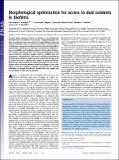| dc.contributor.author | Kempes, Chris Poling | |
| dc.contributor.author | Okegbe, Chinweike | |
| dc.contributor.author | Mears-Clarke, Zwoisaint | |
| dc.contributor.author | Dietrich, Lars E. P. | |
| dc.contributor.author | Follows, Michael J. | |
| dc.date.accessioned | 2014-08-29T14:40:20Z | |
| dc.date.available | 2014-08-29T14:40:20Z | |
| dc.date.issued | 2014-01 | |
| dc.date.submitted | 2013-08 | |
| dc.identifier.issn | 0027-8424 | |
| dc.identifier.issn | 1091-6490 | |
| dc.identifier.uri | http://hdl.handle.net/1721.1/89111 | |
| dc.description.abstract | A major theme driving research in biology is the relationship between form and function. In particular, a longstanding goal has been to understand how the evolution of multicellularity conferred fitness advantages. Here we show that biofilms of the bacterium Pseudomonas aeruginosa produce structures that maximize cellular reproduction. Specifically, we develop a mathematical model of resource availability and metabolic response within colony features. This analysis accurately predicts the measured distribution of two types of electron acceptors: oxygen, which is available from the atmosphere, and phenazines, redox-active antibiotics produced by the bacterium. Using this model, we demonstrate that the geometry of colony structures is optimal with respect to growth efficiency. Because our model is based on resource dynamics, we also can anticipate shifts in feature geometry based on changes to the availability of electron acceptors, including variations in the external availability of oxygen and genetic manipulation that renders the cells incapable of phenazine production. | en_US |
| dc.description.sponsorship | National Science Foundation (U.S.). Graduate Research Fellowship | en_US |
| dc.description.sponsorship | Gordon and Betty Moore Foundation | en_US |
| dc.description.sponsorship | United States. National Aeronautics and Space Administration | en_US |
| dc.description.sponsorship | National Science Foundation (U.S.) | en_US |
| dc.language.iso | en_US | |
| dc.publisher | National Academy of Sciences (U.S.) | en_US |
| dc.relation.isversionof | http://dx.doi.org/10.1073/pnas.1315521110 | en_US |
| dc.rights | Article is made available in accordance with the publisher's policy and may be subject to US copyright law. Please refer to the publisher's site for terms of use. | en_US |
| dc.source | PNAS | en_US |
| dc.title | Morphological optimization for access to dual oxidants in biofilms | en_US |
| dc.type | Article | en_US |
| dc.identifier.citation | Kempes, C. P., C. Okegbe, Z. Mears-Clarke, M. J. Follows, and L. E. P. Dietrich. “Morphological Optimization for Access to Dual Oxidants in Biofilms.” Proceedings of the National Academy of Sciences 111, no. 1 (December 12, 2013): 208–213. | en_US |
| dc.contributor.department | Massachusetts Institute of Technology. Department of Earth, Atmospheric, and Planetary Sciences | en_US |
| dc.contributor.mitauthor | Kempes, Chris Poling | en_US |
| dc.contributor.mitauthor | Follows, Michael J. | en_US |
| dc.relation.journal | Proceedings of the National Academy of Sciences | en_US |
| dc.eprint.version | Final published version | en_US |
| dc.type.uri | http://purl.org/eprint/type/JournalArticle | en_US |
| eprint.status | http://purl.org/eprint/status/PeerReviewed | en_US |
| dspace.orderedauthors | Kempes, C. P.; Okegbe, C.; Mears-Clarke, Z.; Follows, M. J.; Dietrich, L. E. P. | en_US |
| dc.identifier.orcid | https://orcid.org/0000-0002-3102-0341 | |
| dspace.mitauthor.error | true | |
| mit.license | PUBLISHER_POLICY | en_US |
| mit.metadata.status | Complete | |
